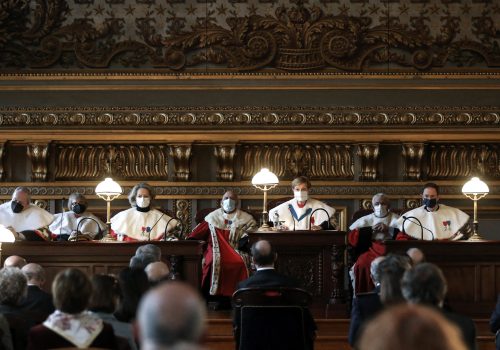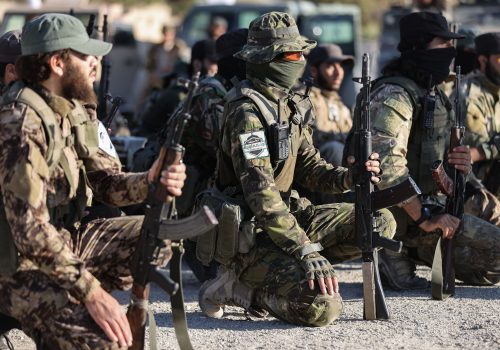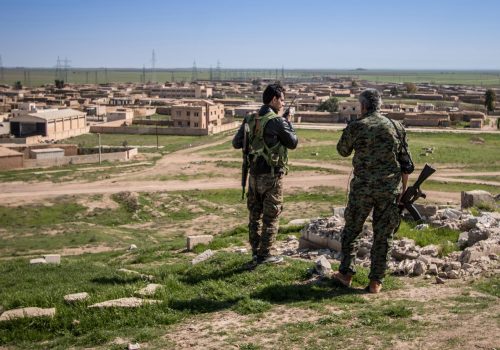Rebel infighting foreshadows the next phase of the Syrian conflict
As if to confirm a cliche of the Syrian war, another round of infighting took place last month between armed opposition groups. Beginning on October 11, clashes broke out between factions of the Syrian National Army (SNA), which were triggered by the murder of activist Muhammad Abdullatif and his pregnant wife in the city of al-Bab in Aleppo province just days before.
Abdullatif, a popular civil society voice, was investigating the alleged involvement of the SNA’s Hamza Division in drug trafficking. His murder caused massive outrage in al-Bab, where the Hamza Division’s presence is rather limited. When the Levant Front, a rival SNA group that maintains a strong presence in the city, identified and arrested the hit team that was allegedly headed by a Hamza Division security man, the two groups went to war.
The resultant clashes would probably have been largely ignored as just another chapter in the endless saga of rebel factionalism. However, when Hayat Tahrir al-Sham (HTS), a powerful jihadist group based in neighboring Idlib province, directly intervened on behalf of the Hamza Division, the issue attracted considerable attention beyond the microcosm of Syria’s armed opposition landscape.
On October 13, HTS forces invaded SNA territory, quickly took over the city of Afrin, and then pushed on Azaz, the de facto capital of northern Aleppo and the stronghold of the Levant Front. The goal of HTS was to dominate all opposition-held areas in the northwest and for its leader, Abu Mohammad al-Jolani, to be recognized as the supreme leader of the Syrian revolution. HTS was advancing fast, and the Levant Front was on the verge of defeat.
What transpired after that was rather interesting because it shows the challenges to Turkey’s Syria policy, what the future holds for the armed opposition, and where the conflict as a whole is headed.
Crossed wires in Ankara
Many Syria watchers speculated whether Ankara had secretly green-lighted HTS’s power grab. They observed how the Turkish National Intelligence Organization (MIT), one of the Turkish agencies tasked with managing the affairs of the armed opposition, looked on as HTS made gains. Drawing on several recent conversations, SNA commanders believed that Turkey’s MIT was happy to see the Levant Front and its allies humbled after years of troubled relations caused by the Levant Front’s insistence on a balanced partnership with Ankara. HTS, they said, was deemed a more reliable “implementer” for Turkey.
The way events unfolded, however, suggests that the Turkish government was split on HTS. Owing perhaps to the different administrative and strategic priorities that animated their Syria policy, the Turkish Defense and Interior ministries adopted a far less accommodating attitude toward HTS. Opposition leaders, who spoke on condition of anonymity, described how different Turkish agencies gave contradictory orders to SNA factions within a space of hours, which they interpreted as a sign of disagreements in Ankara. Nevertheless, on day six of the fighting, the Turkish Army put its foot down and issued its order for HTS to pull its forces back to Idlib. Jolani’s putsch failed.
Details remain unclear as to who exactly issued the order and how. Levant Front sources confirm that, in meetings with Turkish generals, the latter expressed their deep displeasure at the idea of Jolani marching triumphantly into areas the Turkish Army had shed blood to seize from the Islamic State of Iraq and al-Sham (ISIS) and the Kurdish People’s Protection Units (YPG). The generals were also said to be disturbed by the possibility that the YPG would garner foreign support to attack Afrin under the pretext of counter-terrorism, as HTS is still designated as a terrorist entity by the United States, Russia, and Turkey.
Turkey’s slow and somewhat contradictory response to events within its sphere of influence reflects the extent its state bureaucracy has internalized the Syria file. The territories in the northwest protected by Turkish troops fall under the authority of a multitude of Turkish government bodies. Policemen in Azaz, for instance, are trained and paid for by the Interior Ministry. Furthermore, the police chiefs are appointed by the governor (who is himself appointed by the Interior Minister) in the adjacent Turkish province, while MIT manages SNA factions. Hospitals are run by the Health Ministry, mosques by the Religious Affairs Ministry, the courts by the Justice Ministry, and so on. Only in Idlib has HTS managed to create a so-called “Salvation Government” that manages its own services, albeit with a great deal of conditional Turkish state assistance.
Parceling out the governance of opposition-held territories to various Turkish government ministries and agencies creates bureaucratic vested interest and complex reporting lines that complicate decision-making. The task of streamlining and rationalizing the various chains of command and reporting lines now appears to be a priority for Ankara.
Jolani misses his shot
The fortunes of HTS have risen significantly in recent years. The group instituted a technocratic government in Idlib and an effective security arm, and has even launched a PR offensive to underscore how far its leader Jolani has distanced himself from al-Qaeda and the extent to which he is ready to accommodate big power interests. Today, the United States no longer targets HTS kinetically in the way that it did in the past. If anything, the US has discreetly accommodated itself to HTS’s power in Idlib as a bulwark against Russia, while stopping short of delisting the group or recognizing it in any formal way.
That Jolani has managed to grow his organization with a focus on economic, security, and governance capacities reflects his appreciation of the changing nature of the Syrian conflict and the tools and attitudes required to survive it. His unbroken string of victories since 2017 against rivals in the armed opposition may have tempted him to take a gamble by quickly and decisively creating a new reality on the ground.
Whether Jolani’s power grab received a solid green light from Ankara is guesswork. What is certain is that Jolani must have concluded that the relevant external parties—Turkey, Russia, and the West—would live with him as head honcho in northwest Syria. What he did not anticipate was the reaction of the full spectrum of Turkish agencies, and the level of armed and civil resistance that he would face in Azaz. Despite an impressive social media blitz, Jolani came across as more Machiavellian than Che Guevara. His aura of invincibility has been broken, which will likely complicate his prospects as he plans his next moves.
Having survived HTS’s onslaught for the moment, the Levant Front and its allies can claim a victory of sorts. The US statement calling on HTS to withdraw from Afrin gave further encouragement to the Levant Front, which has received US military assistance in the past. Much will depend on the willingness of Turkey to restructure a force capable of balancing the weight of HTS, and the ability of the international community to create conditions in which Syrians have options other than fighting for the spoils of war.
Crossline relations will increasingly shape conflict dynamics
The struggle over economic resources—revenue from internal and external border crossings chief among them—is what drives conflict between a plethora of armed actors in northwest Syria (crossline trade between HTS and SNA factions has increased despite growing rivalries). Relations have become so interwoven that even SNA groups hostile to HTS, such as the Levant Front, facilitate discreet trades between the Syrian Democratic Forces (SDF) and HTS, with the latter buying oil and paying SNA middlemen for transit through their territories.
Since large-scale fighting with forces loyal to Bashar al-Assad ended after a Russian-Turkish ceasefire deal in March 2020, crossline relations have also gained momentum between opposition and regime areas, handled via informal crossings and smuggling routes. HTS has recently attempted to open direct crossings with regime and SDF areas to increase volume and negotiate better terms. In light of this, Jolani’s recent power grab was about monopolizing all crossing points in the northwest and, in so doing, positioning himself as an indispensable local partner of external powers.
Competition over trade routes will continue to be a decisive factor in shaping future dynamics within and between the different areas of control. The anti-HTS bloc in opposition areas faces the challenge of overcoming internal conflicts to consolidate and professionalize its border crossing management. If it fails, the natural law of war economy will likely favor others more able to do so. While the trend toward enhanced crossline relations might fuel further hostilities, the necessity to develop pragmatic crossline arrangements also constitutes one of the few tangible entry points for diplomacy in Syria’s otherwise stalemated conflict.
All sides have interests in promoting trade and other areas of coordination, such as education, civilian travel, energy, and water management. Jolani understands well the significance of crossline relations in regard to the future of conflict dynamics, with his attempted putsch being the latest indication. It would be a grave mistake to leave this crucial opportunity to the likes of the leader of HTS.
Malik al-Abdeh is a conflict resolution expert focused on Syria and managing director of Conflict Mediation Solutions, a consultancy specializing in Track II work.
Lars Hauch is a researcher at Conflict Mediation Solutions. Follow him on Twitter: @LarsHauch.
Further reading
Thu, Feb 10, 2022
A perpetrator of Syrian crimes against humanity went free in France. Here’s why it shouldn’t happen again
MENASource By Michel Duclos
If the scope for changing the course of events in Syria is limited, it’s honorable to take a stand against the abominable crimes of the Bashar al-Assad regime. It would be a great pity for France to be seen as a safe haven for Assad’s accomplices.
Mon, Nov 14, 2022
How a former al-Qaeda affiliate became an existential threat and a wake-up call for the Syrian opposition
MENASource By
The entry and forced withdrawal of Afrin city by Hayat Tahrir al-Sham (HTS) shook local dynamics and may ultimately serve as a wake-up call for the Syrian opposition.
Fri, Sep 3, 2021
Afghanistan demonstrates why it’s time for a clear Syria policy, starting with northeast Syria
MENASource By Reem Salahi
If Afghanistan is to teach us anything, the Biden administration should not ignore Syria by having a non-existent policy. The longer the Syrian conflict continues, the more intractable and unmanageable it becomes.
Image: Fighters belonging to the Third Army Corps of the Turkish-backed Syrian National Army stand guard on the front lines near the town of Mngh, which is controlled by the Syrian regime and the Syrian Democratic Forces.


